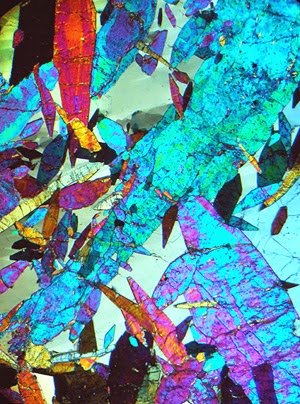
Scientists at Yale University have clarified how carbon dioxide escapes minerals deep inside Earth and seeps into the planet’s atmosphere, a significant step in the planet’s natural carbon cycle. Deeper insight into the cycle helps scientists more accurately assess how humans are altering carbon’s movement and affecting the planet’s climate.
Carbon—the basis for life—is present in the earth, seas, sky, and every living creature. Geologists have long known that significant amounts of carbon are stored as calcium carbonate in certain rocks, such as marble, and returned to the atmosphere through volcanic eruptions. But how calcium carbonate from rocks transforms into carbon dioxide gas has been unclear.
In new research published in the May 2014 issue of Nature Geoscience, the Yale team presents evidence that the mineral aragonite, which is composed of calcium carbonate, can dissolve to release carbon dioxide in water-based fluid. This reaction occurs in high-pressure subduction zones, places where one slab of Earth’s outer rocky shell slides beneath another.
“The dissolution of calcium carbonate in the fluid of subduction zones releases far more carbon dioxide than conventional models predict and could be an important part of the global carbon cycle,” said lead author Jay J. Ague, professor and chair of Yale’s Department of Geology & Geophysics and curator-in-charge of the Mineralogy and Meteoritics collections at the Yale Peabody Museum of Natural History.
Ague’s co-author is Stefan Nicolescu, collection manager for Mineralogy and Meteoritics at the Yale Peabody Museum.
At subduction zones, extreme pressures and temperatures break rocks down and release the carbon as carbon dioxide. The carbon dioxide can become incorporated in magmas that ascend and produce volcanic eruptions, which shoot carbon dioxide back into the atmosphere.
Ague and Nicolescu collected marble rocks from an ancient subduction zone exposed on the Greek islands of Syros and Tinos. Some of the rocks were collected at fluid-flow sites; others were not. They found that the amount of calcium carbonate, the precursor to dissolved carbon dioxide, drastically decreased as they moved closer to fluid conduits. This pattern, they argue, suggests the fluid was instrumental in removing both calcium and carbon dioxide from the rocks.
The discovery of calcium carbonate dissolution did not fit the conventional hypotheses for how carbon dioxide is released from subducted rocks. Devolatilization reactions, which consume or produce water and produce more limited amounts of carbon dioxide, were thought to be the main method of carbon dioxide release from minerals in subduction zones. But these reactions could not account for the large carbon dioxide losses observed in the rock samples, leading Ague and Nicolescu to challenge the conventional wisdom.
Other recent research, including detailed studies of the chemistry of subduction zone fluids, had suggested that other types of reactions might be responsible for carbon dioxide production in subduction zones. What was lacking were field examples suitable for testing hypotheses of carbon dioxide reaction, the researchers said. Ague and Nicolescu argue that the carbon-depleted marbles they found in Greece constitute an important window into how chemical reactions operate to release carbon dioxide from Earth’s deep interior.
Said Ague, “The new hypothesis of carbonate mineral dissolution survived multiple rigorous tests, which was exciting because it can account for geologic relationships that have remained enigmatic for a long time.”
The paper is titled “Carbon dioxide released from subduction zones by fluid-mediated reactions.”
Reference:
“Carbon dioxide released from subduction zones by fluid-mediated reactions.” Jay J. Ague, Stefan Nicolescu. Nature Geoscience (2014) DOI: 10.1038/ngeo2143. Received 19 September 2013 Accepted 17 March 2014 Published online 20 April 2014
Note : The above story is based on materials provided by Yale University










